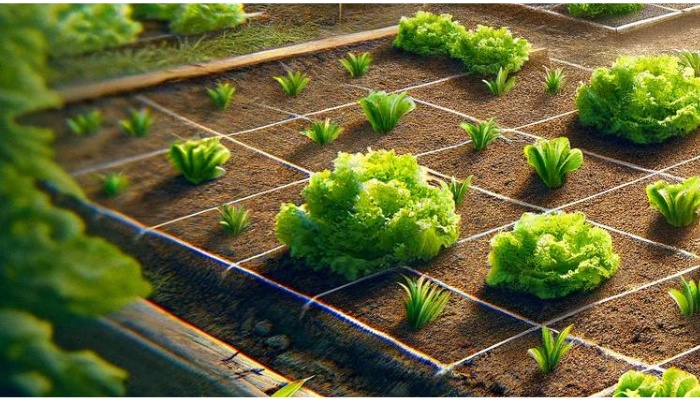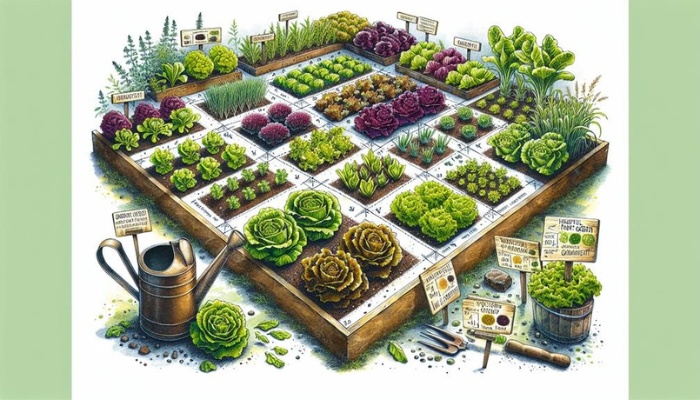Just like a painter needs the right palette to create a masterpiece, you’ll need the right varieties of lettuce to make your square foot garden a success. Selecting the proper types isn’t just about taste; it’s about maximizing your space and yield.
You’ll find that spacing is a critical factor that can make or break your garden’s productivity. With the right soil, fertilization, and watering techniques, you’re on your way to enjoying a lush, vibrant lettuce garden.
Selecting Lettuce Varieties
Choosing the right lettuce varieties can significantly enhance your square foot garden’s yield and diversity. When you’re selecting seeds, consider both your taste preferences and the practicalities of your garden’s climate.
Lettuces come in a wide range from crisphead to leaf varieties, each with its own texture, flavor, and growth habits.
Some lettuces, like romaine, take longer to mature but offer a longer harvest period. Others, such as leaf lettuces, can be harvested earlier and continuously, giving you a steady supply.
This knowledge allows you to plan your garden so that you have a constant stream of fresh lettuce without overwhelming peaks or troughs.
Some of the most popular lettuce varieties to consider include:
- Romaine
- Butterhead
- Arugula
- Spring mix
- Green and red leaf lettuce
- Frisée
Optimal Lettuce Spacing
To maximize your garden’s productivity and ensure healthy growth, it’s critical to space your lettuce plants correctly.
Achieving the perfect balance between overcrowding and under-utilizing your garden space directly influences both germination rates and harvest timing. Here are key points to remember when spacing your lettuce:
- Ideal Spacing: Aim for about 4 inches between each plant. This spacing allows for adequate airflow, reducing the risk of disease, and ensures each lettuce has enough room to grow.
- Square Foot Gardening: In a square foot gardening layout, allocate up to four lettuce plants per square foot. This method optimizes your garden space without compromising plant health.
- Consider Growth Patterns: Different lettuce varieties may require slight adjustments in spacing. Leaf lettuces can be placed closer together, but head-forming types need more room.
- Monitor Growth: As your lettuce plants mature, be prepared to thin them out if necessary to maintain optimal spacing. This not only improves air circulation but also enhances germination rates and harvest timing.
Soil and Fertilization

For optimal lettuce growth, it’s essential to have soil rich in organic matter and apply a balanced fertilizer at the right stages of development.
Start by performing a pH test to ensure your soil is within the 6.0 to 6.8 range ideal for lettuce. This step can’t be skipped as it directly influences nutrient availability.
Incorporate compost into your garden bed to enhance soil structure and fertility.
There are various compost types, including vegetable-based compost, which is rich in nutrients, and well-rotted manure, which provides both nutrients and beneficial microorganisms.
A mix of both can offer your lettuce the best environment for growth.
When it comes to fertilization, a balanced, slow-release fertilizer works wonders. Apply this according to the package instructions, typically at planting and then again mid-season to support continuous growth.
Overfertilization can harm more than help, leading to excess leaf growth at the expense of quality.
Understanding the balance between soil richness and timely fertilization will set the foundation for a bountiful lettuce harvest.
By focusing on pH testing and using the right compost types, you’ll create the perfect growing conditions for your lettuce square foot garden.
Watering Techniques
After ensuring your lettuce garden’s soil is rich and properly fertilized, it’s important to master effective watering techniques for optimal growth.
Lettuce thrives in moist conditions, but overwatering can be just as detrimental as underwatering. Here’s how you can strike the perfect balance:
- Utilize rain collection systems: Rainwater is soft and free from the chemicals found in tap water, making it ideal for your lettuce. Setting up rain barrels can help you collect and store rainwater for dry days, ensuring your plants get the natural hydration they need without over-relying on tap water.
- Invest in drip irrigation systems: Drip systems deliver water directly to the base of each plant, minimizing waste and reducing the evaporation rate. This method not only conserves water but also keeps the leaves dry, reducing the risk of fungal diseases.
- Morning watering routine: Watering in the early morning allows the soil to absorb moisture before the sun’s heat can evaporate it. This timing helps ensure that your lettuce roots receive the hydration they need to grow strong and healthy.
- Monitor soil moisture: Stick your finger about an inch into the soil; if it feels dry, it’s time to water. Overwatering can lead to root rot, so it’s important to check the soil’s moisture level regularly.
Pests and Diseases Management
Managing pests and diseases is imperative for keeping your lettuce garden healthy and productive. Let’s explore how you can protect your plants using biological control and crop rotation among other strategies.
- Aphids: You may notice yellowing leaves and clusters of tiny bugs. Use biological control agents like ladybugs to naturally reduce aphid populations.
- Slugs and Snails: Trails on leaves will be evident. Place barriers, or encourage natural predators like birds. Crop rotation minimizes habitat for these pests.
- Downy Mildew: You’ll notice white patches on leaves. Ensure good air circulation. Apply fungicides if necessary. Crop rotation reduces the risk of recurrence.
- Lettuce Mosaic Virus: Stunted growth is a sign. Remove and destroy infected plants immediately. Practice crop rotation to prevent soil-borne diseases.

